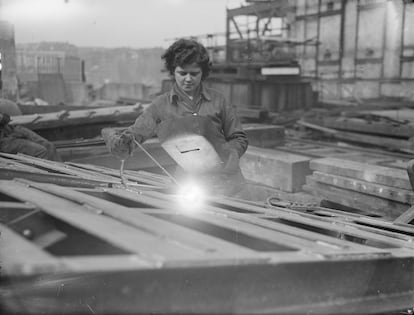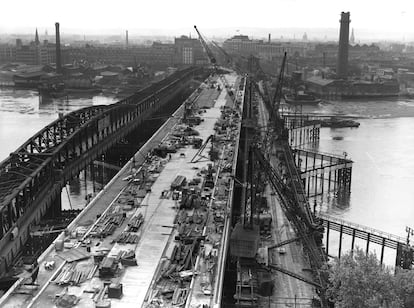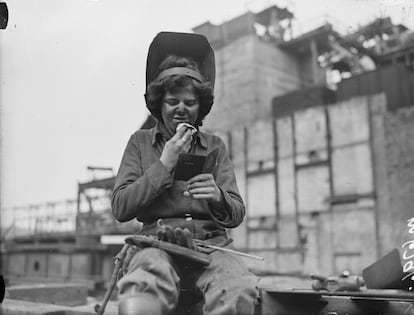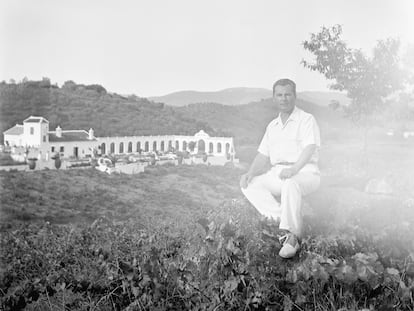How 350 women rebuilt London’s Waterloo Bridge under Nazi bombings
Their incredible work was almost erased from history, but thanks to the documentary ‘The Ladies Bridge’ and the efforts of filmmakers Karen Livesey and Jo Wiser and historian Christine Wall, their contributions have been formally recognized

When he opened Waterloo Bridge in December 1945, Britain’s then-deputy prime minister, Herbert Morrison, made a short speech which included the following statement: “The men who built Waterloo Bridge are fortunate men. They know that although their names may be forgotten, their work will be a pride and use to London for many generations to come.”
Morrison certainly got one thing right: although it is not the most spectacular, the new Waterloo Bridge is a source of pride for Londoners — mainly because it was built under Nazi bombings in World War II. But why was it built at such a dangerous time? Because the war came later.
Opened in 1817, the old Waterloo Bridge was strategically positioned next to Westminster. It not only connected the north and south banks of the city, but also allowed traffic to be diverted from Westminster Bridge, when necessary. However, from 1874 onwards, scour from the river flow of the Thames damaged the foundations of the old bridge, and by the 1920s, the damage had become dangerous. So much so that a parallel steel bridge was built as a temporary solution.

In the 1930s, the authorities decided to demolish the old viaduct and build a new one. The project was carried out by architect Sir Giles Gilbert Scott, who designed an elegant concrete and steel bridge with five spans; a small structural feat at the time.
With a workforce of around 500 men, work on the new Waterloo Bridge began in 1937 and was due to be completed by 1942, but World War II broke out in the middle of construction. Initially, the work was planned to be halted, but when the Nazis began bombing London in 1940, the British government decided that completing the bridge was a matter of “national importance.” It wasn’t just about finishing a feat of engineering, it was about showing to both the Germans and the British that nothing, not even bombs, was going to stop them. It was about sticking to the government’s motivational slogan of “Keep Calm and Carry On.”
The problem was that there was no one to build it. According to records, of the 500 men who began the work, only 150 had not been assigned to military work, either at the front or at British bases. In effect, there were no men to finish the bridge. But there were women.

For while many women took an active part in the war — as nurses, clerks, telephone operators and even pilots — all women made a vital contribution to the war effort: they not only kept the war machine going, they kept their own countries going. With a large part of the male population at the front, hundreds of thousands of women joined the factories where ammunition was made, airplanes were built and tank parts were riveted together. This was the era of Rosie the Riveter.
And it was women who built Waterloo Bridge, too. According to the Women’s Engineering Society, some 350 women began work there in early 1941. Welding, erecting, shuttering, riveting. Sometimes the days were clear, sometimes they had to run to shelters to escape the Luftwaffe bombs. They worked eight-, 10- and 12-hour days, Monday to Sunday. With the sole aim of finishing the job in 1942. And they succeeded.
The new Waterloo Bridge was officially opened in September 1942, although it was not fully completed until December 1945. And although the deputy prime minister “forgot” (so to speak) about women in his speech, Londoners did not. During the post-war years, people in London referred to the bridge as “The Ladies Bridge.” Indeed, when riverboats on the Thames passed under the Waterloo Bridge, captains commonly announced it by its nickname.

But Morrison got something else right: their names were forgotten. There was no record of these women, no document to prove what Londoners knew. By 2000, the story had become practically a rumor, an urban legend. Until, in 2005, filmmakers Karen Livesey and Jo Wiser decided to find how much truth there was in the story. They looked for women who had worked on the bridge, for their relatives, for anyone who had a story about the women on the bridge. And they recorded these testimonies in their documentary, The Ladies Bridge.
But it was still just oral memory. The filmmakers needed concrete evidence. They tried looking into the archives of Peter Lind & Company, the bridge contractor, but discovered that the company went bankrupt in the 1980s and all its documents were missing. Then, in 2015, they were contacted by historian Christine Wall, who had been researching the same matter for some time. She had found a lead in the archives of the National Science and Media Museum. And there, one morning in 2015, they found Dorothy.
Amid a web of photos and online listings, Wall found several Daily Herald photographs of women working on the Waterloo Bridge. Among them were three photos dated 1944 of a female welder identified only as “Dorothy.”
Following the discovery of Dorothy and the other images, Historic England — the body responsible for protecting England’s heritage — officially recognized women’s contribution to the construction of the bridge, and gave it a Grade II listed status.
So if you ever go on a boat on the Thames and the captain talks about “The Ladies’ Bridge,” you should know that it is not an urban legend. That it was there that Dorothy and 350 other women worked alongside 150 men, building Waterloo Bridge amid the Nazi bombings.
Sign up for our weekly newsletter to get more English-language news coverage from EL PAÍS USA Edition
Tu suscripción se está usando en otro dispositivo
¿Quieres añadir otro usuario a tu suscripción?
Si continúas leyendo en este dispositivo, no se podrá leer en el otro.
FlechaTu suscripción se está usando en otro dispositivo y solo puedes acceder a EL PAÍS desde un dispositivo a la vez.
Si quieres compartir tu cuenta, cambia tu suscripción a la modalidad Premium, así podrás añadir otro usuario. Cada uno accederá con su propia cuenta de email, lo que os permitirá personalizar vuestra experiencia en EL PAÍS.
¿Tienes una suscripción de empresa? Accede aquí para contratar más cuentas.
En el caso de no saber quién está usando tu cuenta, te recomendamos cambiar tu contraseña aquí.
Si decides continuar compartiendo tu cuenta, este mensaje se mostrará en tu dispositivo y en el de la otra persona que está usando tu cuenta de forma indefinida, afectando a tu experiencia de lectura. Puedes consultar aquí los términos y condiciones de la suscripción digital.
More information
Últimas noticias
Most viewed
- Sinaloa Cartel war is taking its toll on Los Chapitos
- Reinhard Genzel, Nobel laureate in physics: ‘One-minute videos will never give you the truth’
- Oona Chaplin: ‘I told James Cameron that I was living in a treehouse and starting a permaculture project with a friend’
- Why the price of coffee has skyrocketed: from Brazilian plantations to specialty coffee houses
- David King, chemist: ‘There are scientists studying how to cool the planet; nobody should stop these experiments from happening’











































